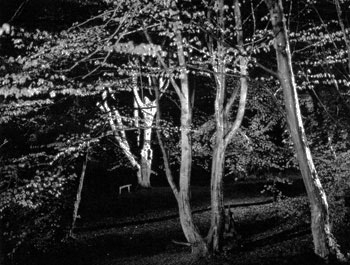Adam Chodzko
Ikon Gallery, Birmingham, UK
Art Monthly, Issue 229, Sep 1999

Image: Adam Chodzko, Nightvision
The projection has the blue tint and heavy pixellation of an image-intensifier. This means that what we're witnessing is happening at night, lending a clandestine edge to whatever it is that's going on. What can we see? We are in a wood. Four people dressed in heavy waterproofs are working intently on various pieces of equipment - tripods, maybe. A muffled soundtrack of voices plays alongside the video - calm and thoughtful voices littered with technical jargon. 'I'd put a 20 or 10K behind a huge frame with graduated gels; just strips of gels across, creating all your graduated colours and they'll bleed into each other and create a rainbowy effect.' Lights, then; they're talking about lights. Perhaps the equipment they're setting up is some kind of lighting rig. 'A way that I see Heaven being lit is with one of the old Brute lamps.' Gradually, we understand that these people are lighting technicians, setting up a rig to illuminate an area in the way that they imagine Heaven would be lit. After 15 minutes of this - requiring patience and perseverance from the viewer - all goes quiet. Something's about to happen. The huge clang and deep thrum of a large power switch being thrown kills the projection while another on the opposite wall flashes blindingly into life. So here it is then, at last. Heaven.
After the impoverished resolution of the previous image, this coloured scene is strangely affecting, partly because of what we see, but mostly because of what we know: we know what it's meant to be. Trees glow with strange yellows and blues. A clearing is stained red. The high-voltage hum reminds us that a certain awed respect is expected of us. Then - click - one by one the lights shut off, leaving blackness. Heaven has gone. We cannot even see the woods now, as if such everyday sights were beneath our newly heightened consciousness of Platonic idealised spaces. The tape stops, rewinds, clunks back on and we're back on the other wall with shuffling anoraks and garbled talk of golden sunlight and arc lamps.
Nightvision is classic Adam Chodzko. It begins with a simple but entirely subjective question ('How would you light Heaven?'), allows a group of strangers to answer it in their own way (concert lighting technicians), and then follows the process through to a kind of unforeseen, make-do epiphany. By asking such unanswerable questions (often religious because of their loaded ambiguity) Chodzko solicits extremely personal replies. But these replies depend on cultural factors too, and so together they build a rich image of a collective consciousness.
Chodzko was part of the overexposed group that seemed to be part of every group show in the 90s. But the problem with numerous group shows is that the same few works end up being shown all the time: Chodzko? Yeah, he's the one that does Loot adverts, blood red drips and God look-alike contests, isn't he? (The International God Look-Alike Contest, which began in 1995, is showing here.) But we have actually seen very little of Chodzko's output in this country, and the works we have seen tend to be the more straightforward projects, like the God look-alikes. This is all very well, but there's much more to Chodzko than this and, what's more, the most interesting projects are often those that have had room to develop, like Reunion: Salo (a project carried out in Italy last year and on show here) or A Place for The End.
Chodzko advertised for a group of eight volunteers from the Birmingham area. Each was to choose a place in the city that they thought could be the setting for the closing scene of a film. Various documentation was made, including stills and an odd video work. Again, questions of collective consciousness emerge, both at the large 'movie-going public' scale, as well as the 'Birmingham resident' scale. Again it forces us to provide our own answers to the question: 'Yes, that's a good location. No, that one's not. I would have it at ...' etc. But it goes a step further than Nightvision in that it also provides a leaflet of locations allowing us to go and visit these eight places. What's more, each location bears a plaque with instructions on where to stand and where to look. The scenes that the volunteers chose now have an aura for every passer-by. Suddenly the scenes (not the locations, but particular widescreen views within them) are imbued with the power of fiction. The everyday becomes invisible; we see it through an imaginary lens. This is Chodzko's favourite trick of flipping the everyday into the extraordinary, showing how collective fictions anchor private imagination, and how mundane experiences can slip first into one, and then the other.
This piece was commissioned by the Ikon Gallery, which makes sense as only Birmingham residents are likely to visit all the sites. At a time when arts funding comes with so many community strings attached - art for everyone - Chodzko shows that such conditions need not be restraints. Public art doesn't have to involve workshops to involve the community, and it doesn't have to be heavy to be deep.
— End —